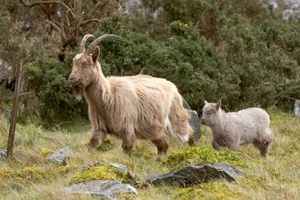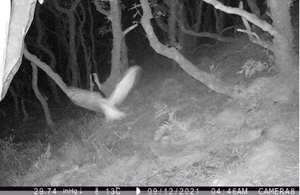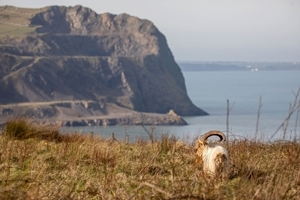 This project came about due to concerns from Nant Gwrtheyrn Welsh language centre that, over lockdown, the goat population had seemed to increase and become bolder. They had experienced high impacts of damage on plantings and fencing around the centre.
This project came about due to concerns from Nant Gwrtheyrn Welsh language centre that, over lockdown, the goat population had seemed to increase and become bolder. They had experienced high impacts of damage on plantings and fencing around the centre.
The GWCT was asked to look at the goat population as no work had been done before, and there needed to be baseline data collected and observation made before any mitigating measures could be put in place.
The feral goat population in the area are a unique group, as they are and have been isolated for a long time without mixing with other populations. The Nant/Eifl group have a distinct pelage – a pale brown colour – and are distinctively smaller in stature than other goat populations in Snowdonia.
They are an iconic species and deserve study to look at the health, origins, impacts and future expansion.
Trail cameras
 In June 2021 we deployed ten trail cameras. One was initially located on the fence line in front of the café (placed by Matt Baker on Countryfile), and it was soon apparent that this area would be overgrown with bracken and visibility was restricted. This camera was moved to the quarry workings above the beach and incline. Five cameras were located in Gallt y Bwlch SSSI woodland, two in the centre’s conifer and broadleaf woodland, and a further two cameras in the quarry area looking down on the centre.
In June 2021 we deployed ten trail cameras. One was initially located on the fence line in front of the café (placed by Matt Baker on Countryfile), and it was soon apparent that this area would be overgrown with bracken and visibility was restricted. This camera was moved to the quarry workings above the beach and incline. Five cameras were located in Gallt y Bwlch SSSI woodland, two in the centre’s conifer and broadleaf woodland, and a further two cameras in the quarry area looking down on the centre.
We captured a number of other animals and birds on the trail cameras, including:
- Badgers
- Foxes
- Grey squirrels
- Mice
- Various birds
Artificial intelligence recognition of feral goats
 Liverpool John Moores University is currently tagging photos to train an AI recognition algorithm. They will then assess images to categorise them and give seasonality and a heat map of detection rate.
Liverpool John Moores University is currently tagging photos to train an AI recognition algorithm. They will then assess images to categorise them and give seasonality and a heat map of detection rate.
Drone work
This work was undertaken using a DJI Matrice 300 coupled with a H20T camera.
The camera has a wide-angle lens, laser range finder, 200x zoom camera, and 9x zoom thermal camera. The thermal camera is exceptional at locating heat signatures of animals, and with the zoom camera you are then able to zoom into individuals for identification.
During the summer months it was apparent that midday flights utilising the thermal camera for spotting animals was challenging, as rocks and other absorbent materials would heat up and confuse locating animals. It was still possible to distinguish animals, but comparing the contrast to winter observations was significantly clearer.
During the winter flights, animals were evident from up to 2km away. As the terrain is so undulating, the drone flights proved very useful in detecting all animals, and we are currently working on a methodology for systematic surveys of large mammals. This has not been done in Britain before, as direct counts have been the standard procedure.